MATH 223: Linear Algebra Assignment Solutions - McGill University
VerifiedAdded on 2023/05/31
|13
|2638
|468
Homework Assignment
AI Summary
This document presents a detailed solution to a Linear Algebra assignment, likely for a MATH 223 course. The solution covers various concepts, including finding the matrix representation of a linear transformation with respect to different bases, determining the null space and image of a linear transformation, verifying inner product axioms, applying the Gram-Schmidt orthogonalization process, and finding orthogonal projections. It also addresses eigenvalue and eigenvector computations, along with proofs related to uniqueness in linear algebra contexts. The assignment tackles problems involving vector spaces, polynomial spaces, and matrix spaces, showcasing a comprehensive understanding of linear algebra principles and problem-solving techniques. Desklib offers a wealth of similar solved assignments and past papers to aid students in their studies.

Running head: ASSIGNMENT 1
Linear Algebra
Student Name
Institution
Linear Algebra
Student Name
Institution
Paraphrase This Document
Need a fresh take? Get an instant paraphrase of this document with our AI Paraphraser
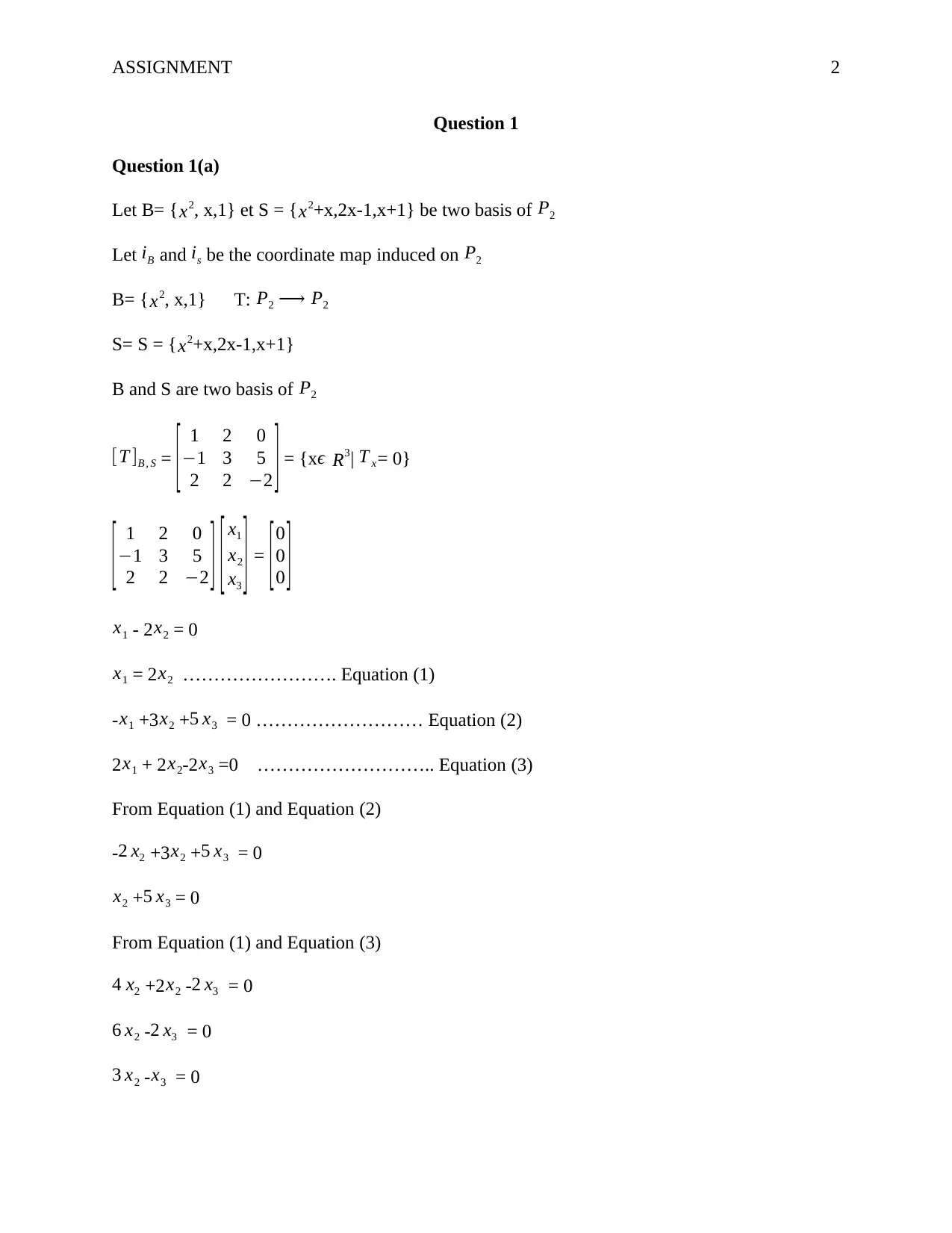
ASSIGNMENT 2
Question 1
Question 1(a)
Let B= { x2, x,1} et S = { x2+x,2x-1,x+1} be two basis of P2
Let iB and is be the coordinate map induced on P2
B= { x2, x,1} T: P2 ⟶ P2
S= S = { x2+x,2x-1,x+1}
B and S are two basis of P2
[T ]B , S = [ 1 2 0
−1 3 5
2 2 −2 ] = {xϵ R3| T x= 0}
[ 1 2 0
−1 3 5
2 2 −2 ] [ x1
x2
x3 ] = [ 0
0
0 ]
x1 - 2x2 = 0
x1 = 2 x2 ……………………. Equation (1)
- x1 +3 x2 +5 x3 = 0 ……………………… Equation (2)
2x1 + 2x2-2 x3 =0 ……………………….. Equation (3)
From Equation (1) and Equation (2)
-2 x2 +3 x2 +5 x3 = 0
x2 +5 x3 = 0
From Equation (1) and Equation (3)
4 x2 +2x2 -2 x3 = 0
6 x2 -2 x3 = 0
3 x2 - x3 = 0
Question 1
Question 1(a)
Let B= { x2, x,1} et S = { x2+x,2x-1,x+1} be two basis of P2
Let iB and is be the coordinate map induced on P2
B= { x2, x,1} T: P2 ⟶ P2
S= S = { x2+x,2x-1,x+1}
B and S are two basis of P2
[T ]B , S = [ 1 2 0
−1 3 5
2 2 −2 ] = {xϵ R3| T x= 0}
[ 1 2 0
−1 3 5
2 2 −2 ] [ x1
x2
x3 ] = [ 0
0
0 ]
x1 - 2x2 = 0
x1 = 2 x2 ……………………. Equation (1)
- x1 +3 x2 +5 x3 = 0 ……………………… Equation (2)
2x1 + 2x2-2 x3 =0 ……………………….. Equation (3)
From Equation (1) and Equation (2)
-2 x2 +3 x2 +5 x3 = 0
x2 +5 x3 = 0
From Equation (1) and Equation (3)
4 x2 +2x2 -2 x3 = 0
6 x2 -2 x3 = 0
3 x2 - x3 = 0
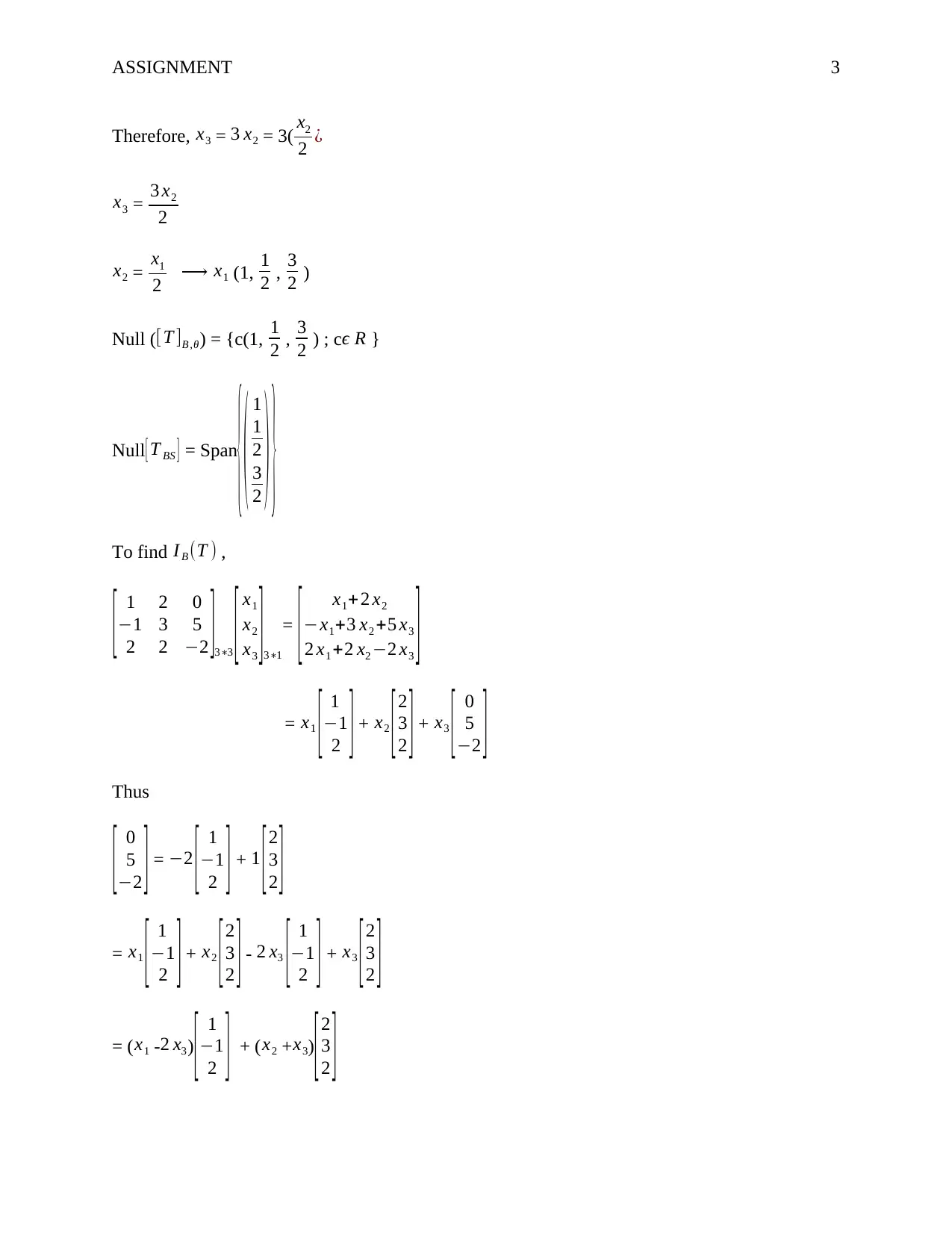
ASSIGNMENT 3
Therefore, x3 = 3 x2 = 3( x2
2 ¿
x3 = 3 x2
2
x2 = x1
2 ⟶ x1 (1, 1
2 , 3
2 )
Null ( [T ]B ,θ) = {c(1, 1
2 , 3
2 ) ; cϵ R }
Null [ T BS ] = Span
{( 1
1
2
3
2 ) }
To find I B (T ) ,
[ 1 2 0
−1 3 5
2 2 −2 ]3∗3 [ x1
x2
x3 ]3∗1
= [ x1+2 x2
−x1+3 x2 +5 x3
2 x1 +2 x2 −2 x3 ]
= x1
[ 1
−1
2 ] + x2
[ 2
3
2 ] + x3
[ 0
5
−2 ]
Thus
[ 0
5
−2 ] = −2 [ 1
−1
2 ] + 1 [2
3
2 ]
= x1
[ 1
−1
2 ] + x2
[ 2
3
2 ] - 2 x3
[ 1
−1
2 ] + x3
[2
3
2 ]
= ( x1 -2 x3)
[ 1
−1
2 ] + ( x2 + x3)
[2
3
2 ]
Therefore, x3 = 3 x2 = 3( x2
2 ¿
x3 = 3 x2
2
x2 = x1
2 ⟶ x1 (1, 1
2 , 3
2 )
Null ( [T ]B ,θ) = {c(1, 1
2 , 3
2 ) ; cϵ R }
Null [ T BS ] = Span
{( 1
1
2
3
2 ) }
To find I B (T ) ,
[ 1 2 0
−1 3 5
2 2 −2 ]3∗3 [ x1
x2
x3 ]3∗1
= [ x1+2 x2
−x1+3 x2 +5 x3
2 x1 +2 x2 −2 x3 ]
= x1
[ 1
−1
2 ] + x2
[ 2
3
2 ] + x3
[ 0
5
−2 ]
Thus
[ 0
5
−2 ] = −2 [ 1
−1
2 ] + 1 [2
3
2 ]
= x1
[ 1
−1
2 ] + x2
[ 2
3
2 ] - 2 x3
[ 1
−1
2 ] + x3
[2
3
2 ]
= ( x1 -2 x3)
[ 1
−1
2 ] + ( x2 + x3)
[2
3
2 ]
⊘ This is a preview!⊘
Do you want full access?
Subscribe today to unlock all pages.

Trusted by 1+ million students worldwide
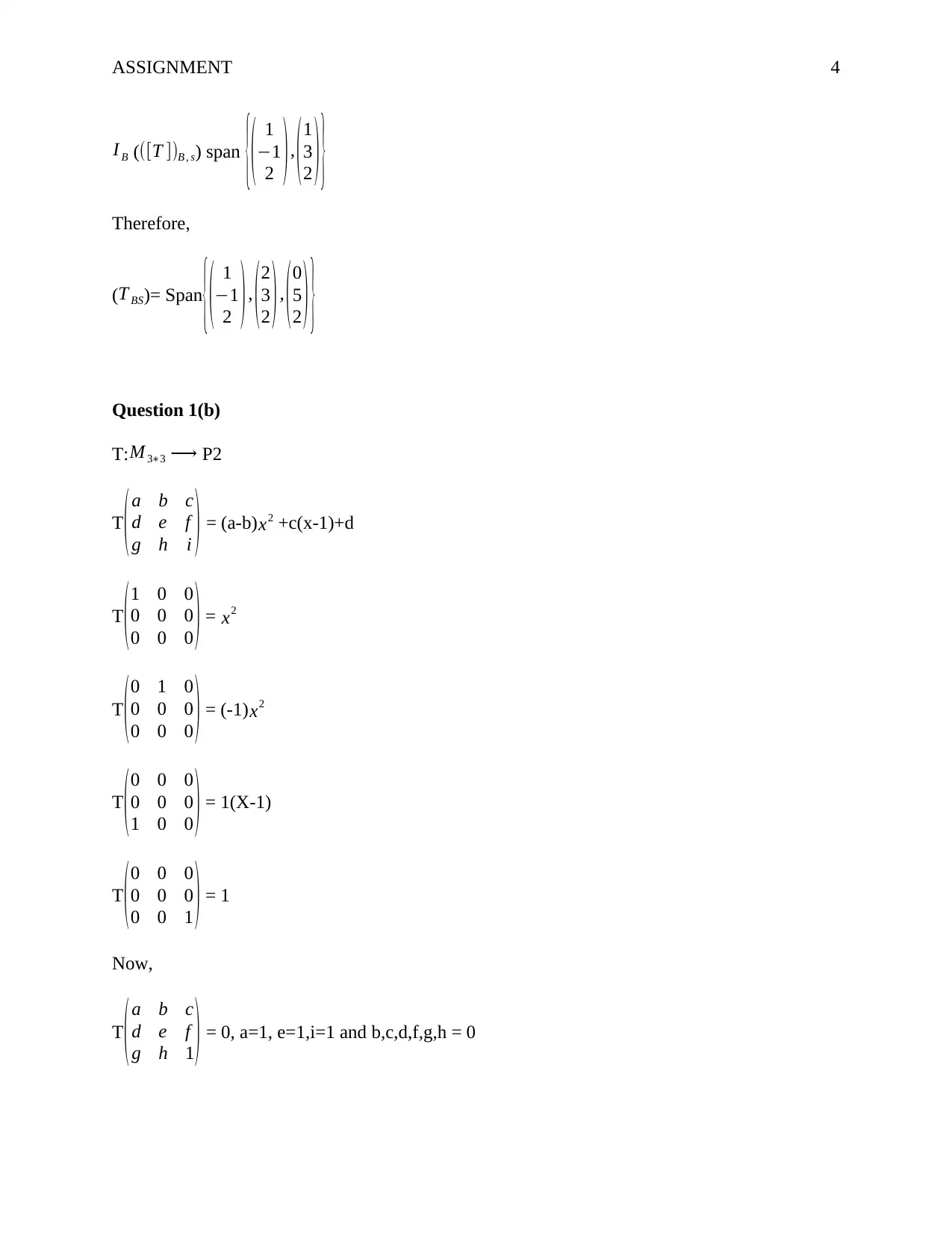
ASSIGNMENT 4
I B (([T ])B , s) span {( 1
−1
2 ) , ( 1
3
2 ) }
Therefore,
(T BS)= Span {( 1
−1
2 ), (2
3
2 ), (0
5
2 ) }
Question 1(b)
T: M 3∗3 ⟶ P2
T
(a b c
d e f
g h i ) = (a-b) x2 +c(x-1)+d
T
(1 0 0
0 0 0
0 0 0 ) = x2
T
(0 1 0
0 0 0
0 0 0 ) = (-1) x2
T
(0 0 0
0 0 0
1 0 0 ) = 1(X-1)
T
(0 0 0
0 0 0
0 0 1 ) = 1
Now,
T
(a b c
d e f
g h 1) = 0, a=1, e=1,i=1 and b,c,d,f,g,h = 0
I B (([T ])B , s) span {( 1
−1
2 ) , ( 1
3
2 ) }
Therefore,
(T BS)= Span {( 1
−1
2 ), (2
3
2 ), (0
5
2 ) }
Question 1(b)
T: M 3∗3 ⟶ P2
T
(a b c
d e f
g h i ) = (a-b) x2 +c(x-1)+d
T
(1 0 0
0 0 0
0 0 0 ) = x2
T
(0 1 0
0 0 0
0 0 0 ) = (-1) x2
T
(0 0 0
0 0 0
1 0 0 ) = 1(X-1)
T
(0 0 0
0 0 0
0 0 1 ) = 1
Now,
T
(a b c
d e f
g h 1) = 0, a=1, e=1,i=1 and b,c,d,f,g,h = 0
Paraphrase This Document
Need a fresh take? Get an instant paraphrase of this document with our AI Paraphraser
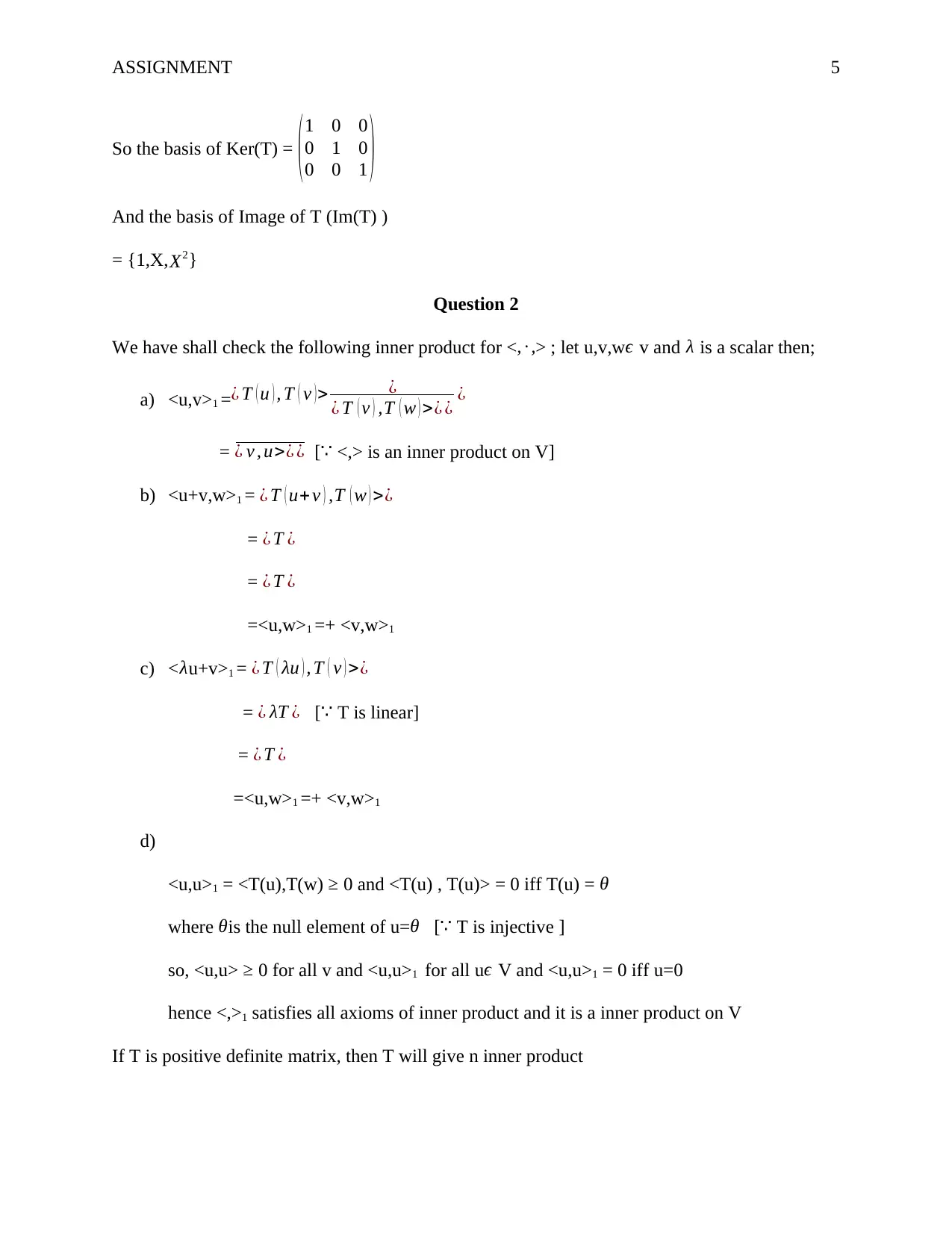
ASSIGNMENT 5
So the basis of Ker(T) = ( 1 0 0
0 1 0
0 0 1 )
And the basis of Image of T (Im(T) )
= {1,X, X2}
Question 2
We have shall check the following inner product for < , ∙ ,> ; let u,v,wϵ v and λ is a scalar then;
a) <u,v>1 =¿ T ( u ) , T ( v )> ¿
¿ T ( v ) ,T ( w ) >¿ ¿ ¿
= ¿ v , u>¿ ¿ [∵ <,> is an inner product on V]
b) <u+v,w>1 = ¿ T ( u+ v ) ,T ( w ) >¿
= ¿ T ¿
= ¿ T ¿
=<u,w>1 =+ <v,w>1
c) <λu+v>1 = ¿ T ( λu ) , T ( v ) >¿
= ¿ λT ¿ [∵ T is linear]
= ¿ T ¿
=<u,w>1 =+ <v,w>1
d)
<u,u>1 = <T(u),T(w) ≥ 0 and <T(u) , T(u)> = 0 iff T(u) = θ
where θis the null element of u=θ [∵ T is injective ]
so, <u,u> ≥ 0 for all v and <u,u>1 for all uϵ V and <u,u>1 = 0 iff u=0
hence <,>1 satisfies all axioms of inner product and it is a inner product on V
If T is positive definite matrix, then T will give n inner product
So the basis of Ker(T) = ( 1 0 0
0 1 0
0 0 1 )
And the basis of Image of T (Im(T) )
= {1,X, X2}
Question 2
We have shall check the following inner product for < , ∙ ,> ; let u,v,wϵ v and λ is a scalar then;
a) <u,v>1 =¿ T ( u ) , T ( v )> ¿
¿ T ( v ) ,T ( w ) >¿ ¿ ¿
= ¿ v , u>¿ ¿ [∵ <,> is an inner product on V]
b) <u+v,w>1 = ¿ T ( u+ v ) ,T ( w ) >¿
= ¿ T ¿
= ¿ T ¿
=<u,w>1 =+ <v,w>1
c) <λu+v>1 = ¿ T ( λu ) , T ( v ) >¿
= ¿ λT ¿ [∵ T is linear]
= ¿ T ¿
=<u,w>1 =+ <v,w>1
d)
<u,u>1 = <T(u),T(w) ≥ 0 and <T(u) , T(u)> = 0 iff T(u) = θ
where θis the null element of u=θ [∵ T is injective ]
so, <u,u> ≥ 0 for all v and <u,u>1 for all uϵ V and <u,u>1 = 0 iff u=0
hence <,>1 satisfies all axioms of inner product and it is a inner product on V
If T is positive definite matrix, then T will give n inner product
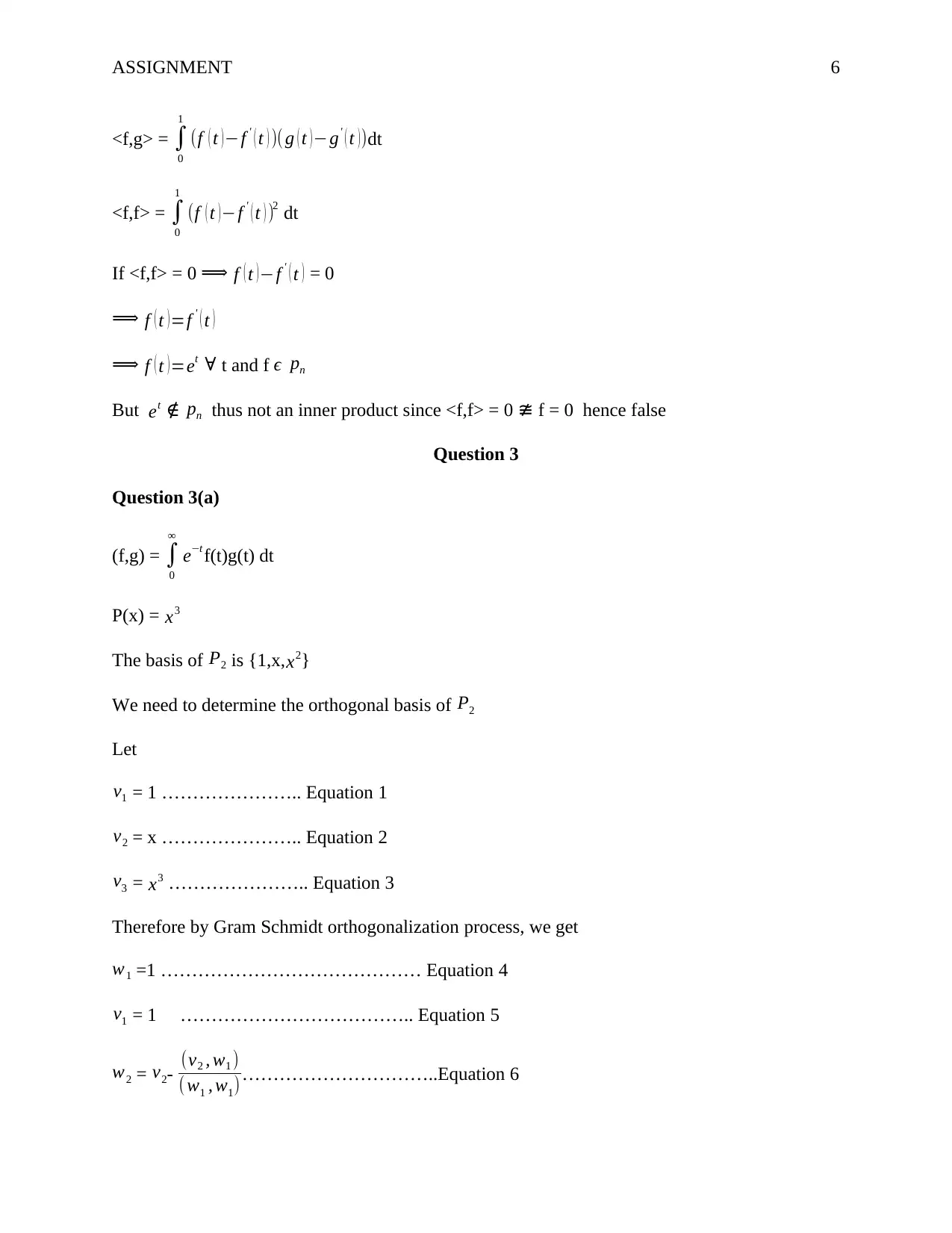
ASSIGNMENT 6
<f,g> = ∫
0
1
(f ( t ) −f ' ( t ) )( g ( t ) −g' ( t ) )dt
<f,f> = ∫
0
1
(f ( t )−f ' ( t ) )2 dt
If <f,f> = 0 ⟹ f ( t )−f ' ( t ) = 0
⟹ f ( t )=f ' ( t )
⟹ f ( t )=et ∀ t and f ϵ pn
But et ∉ pn thus not an inner product since <f,f> = 0 ≇ f = 0 hence false
Question 3
Question 3(a)
(f,g) = ∫
0
∞
e−t f(t)g(t) dt
P(x) = x3
The basis of P2 is {1,x,x2}
We need to determine the orthogonal basis of P2
Let
v1 = 1 ………………….. Equation 1
v2 = x ………………….. Equation 2
v3 = x3 ………………….. Equation 3
Therefore by Gram Schmidt orthogonalization process, we get
w1 =1 …………………………………… Equation 4
v1 = 1 ……………………………….. Equation 5
w2 = v2- (v2 , w1 )
(w1 , w1)…………………………..Equation 6
<f,g> = ∫
0
1
(f ( t ) −f ' ( t ) )( g ( t ) −g' ( t ) )dt
<f,f> = ∫
0
1
(f ( t )−f ' ( t ) )2 dt
If <f,f> = 0 ⟹ f ( t )−f ' ( t ) = 0
⟹ f ( t )=f ' ( t )
⟹ f ( t )=et ∀ t and f ϵ pn
But et ∉ pn thus not an inner product since <f,f> = 0 ≇ f = 0 hence false
Question 3
Question 3(a)
(f,g) = ∫
0
∞
e−t f(t)g(t) dt
P(x) = x3
The basis of P2 is {1,x,x2}
We need to determine the orthogonal basis of P2
Let
v1 = 1 ………………….. Equation 1
v2 = x ………………….. Equation 2
v3 = x3 ………………….. Equation 3
Therefore by Gram Schmidt orthogonalization process, we get
w1 =1 …………………………………… Equation 4
v1 = 1 ……………………………….. Equation 5
w2 = v2- (v2 , w1 )
(w1 , w1)…………………………..Equation 6
⊘ This is a preview!⊘
Do you want full access?
Subscribe today to unlock all pages.

Trusted by 1+ million students worldwide
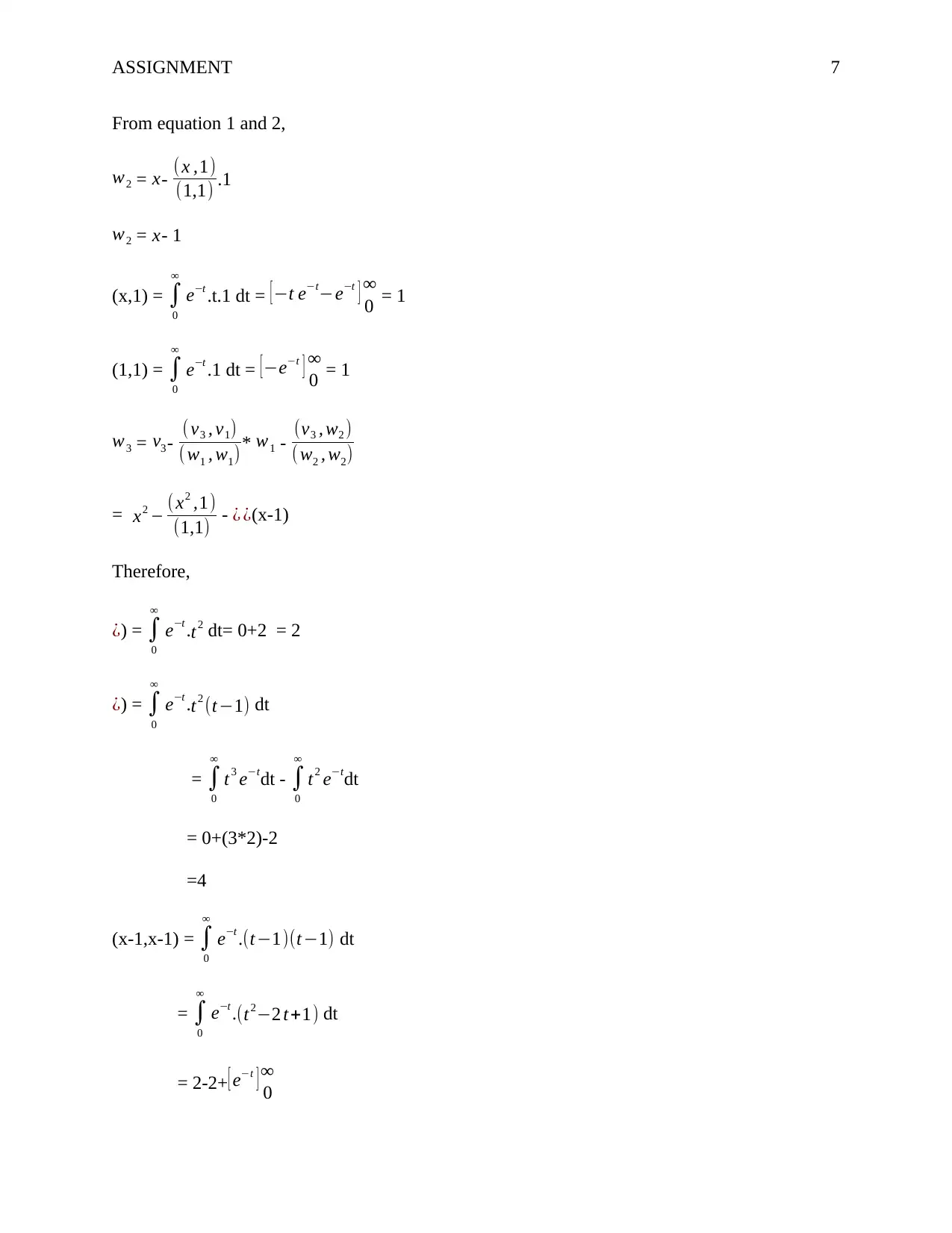
ASSIGNMENT 7
From equation 1 and 2,
w2 = x- ( x ,1)
(1,1) .1
w2 = x- 1
(x,1) = ∫
0
∞
e−t .t.1 dt = [ −t e−t−e−t ] ∞
0 = 1
(1,1) = ∫
0
∞
e−t .1 dt = [ −e−t ] ∞
0 = 1
w3 = v3- ( v3 , v1)
( w1 , w1)* w1 - (v3 , w2 )
( w2 , w2)
= x2 – ( x2 ,1)
(1,1) - ¿ ¿(x-1)
Therefore,
¿) = ∫
0
∞
e−t .t2 dt= 0+2 = 2
¿) = ∫
0
∞
e−t .t2 (t−1) dt
= ∫
0
∞
t3 e−tdt - ∫
0
∞
t2 e−tdt
= 0+(3*2)-2
=4
(x-1,x-1) = ∫
0
∞
e−t .(t−1)(t−1) dt
= ∫
0
∞
e−t .(t2−2 t+1) dt
= 2-2+ [ e−t ] ∞
0
From equation 1 and 2,
w2 = x- ( x ,1)
(1,1) .1
w2 = x- 1
(x,1) = ∫
0
∞
e−t .t.1 dt = [ −t e−t−e−t ] ∞
0 = 1
(1,1) = ∫
0
∞
e−t .1 dt = [ −e−t ] ∞
0 = 1
w3 = v3- ( v3 , v1)
( w1 , w1)* w1 - (v3 , w2 )
( w2 , w2)
= x2 – ( x2 ,1)
(1,1) - ¿ ¿(x-1)
Therefore,
¿) = ∫
0
∞
e−t .t2 dt= 0+2 = 2
¿) = ∫
0
∞
e−t .t2 (t−1) dt
= ∫
0
∞
t3 e−tdt - ∫
0
∞
t2 e−tdt
= 0+(3*2)-2
=4
(x-1,x-1) = ∫
0
∞
e−t .(t−1)(t−1) dt
= ∫
0
∞
e−t .(t2−2 t+1) dt
= 2-2+ [ e−t ] ∞
0
Paraphrase This Document
Need a fresh take? Get an instant paraphrase of this document with our AI Paraphraser
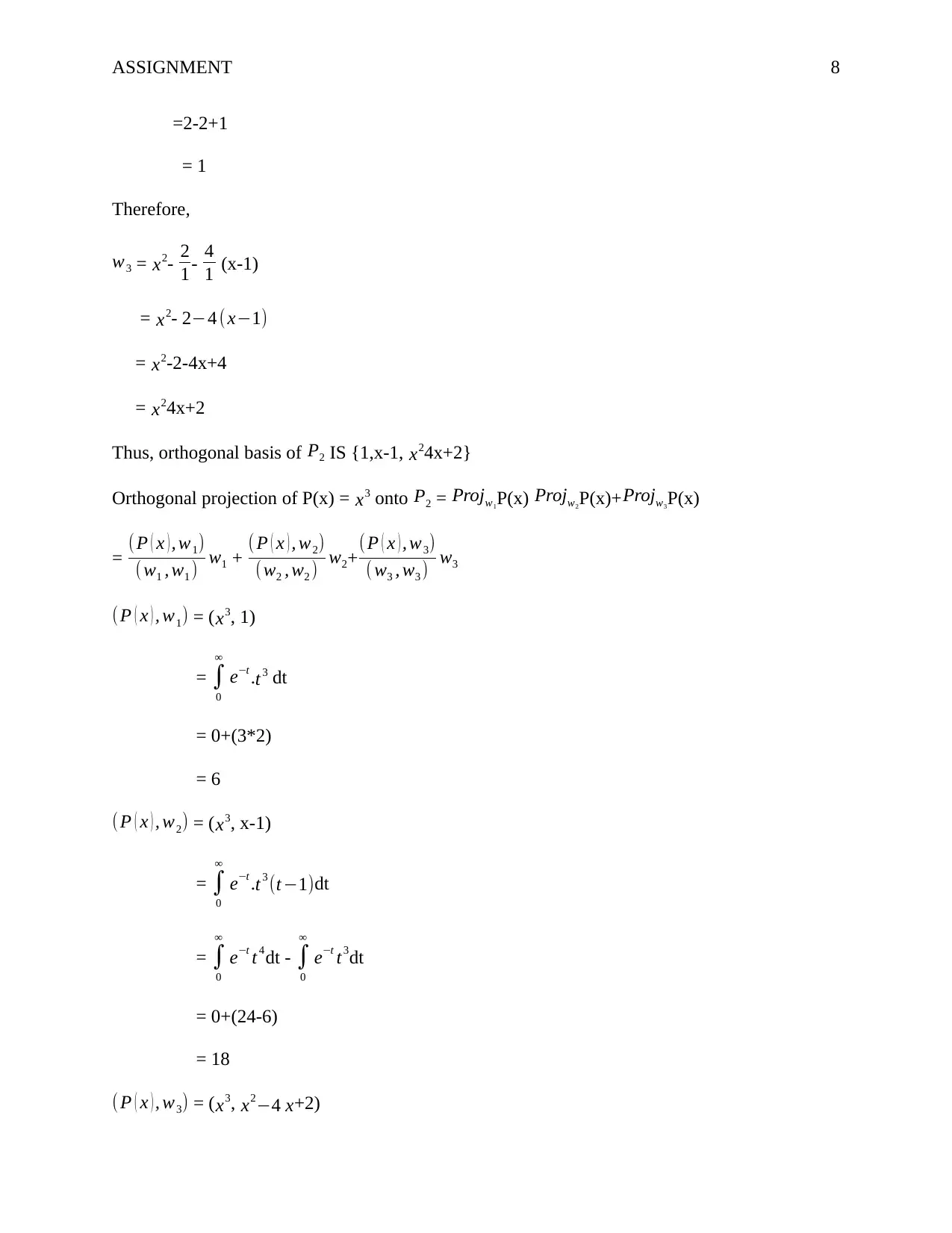
ASSIGNMENT 8
=2-2+1
= 1
Therefore,
w3 = x2- 2
1- 4
1 (x-1)
= x2- 2−4 (x−1)
= x2-2-4x+4
= x24x+2
Thus, orthogonal basis of P2 IS {1,x-1, x24x+2}
Orthogonal projection of P(x) = x3 onto P2 = Projw1P(x) Projw2P(x)+Projw3P(x)
= ( P ( x ) , w1)
( w1 , w1 ) w1 + ( P ( x ) , w2)
(w2 , w2 ) w2+( P ( x ) , w3)
( w3 , w3 ) w3
(P ( x ) , w1) = ( x3, 1)
= ∫
0
∞
e−t .t3 dt
= 0+(3*2)
= 6
(P ( x ) , w2) = ( x3, x-1)
= ∫
0
∞
e−t .t3 (t−1)dt
= ∫
0
∞
e−t t4dt - ∫
0
∞
e−t t3dt
= 0+(24-6)
= 18
(P ( x ) , w3) = (x3, x2−4 x+2)
=2-2+1
= 1
Therefore,
w3 = x2- 2
1- 4
1 (x-1)
= x2- 2−4 (x−1)
= x2-2-4x+4
= x24x+2
Thus, orthogonal basis of P2 IS {1,x-1, x24x+2}
Orthogonal projection of P(x) = x3 onto P2 = Projw1P(x) Projw2P(x)+Projw3P(x)
= ( P ( x ) , w1)
( w1 , w1 ) w1 + ( P ( x ) , w2)
(w2 , w2 ) w2+( P ( x ) , w3)
( w3 , w3 ) w3
(P ( x ) , w1) = ( x3, 1)
= ∫
0
∞
e−t .t3 dt
= 0+(3*2)
= 6
(P ( x ) , w2) = ( x3, x-1)
= ∫
0
∞
e−t .t3 (t−1)dt
= ∫
0
∞
e−t t4dt - ∫
0
∞
e−t t3dt
= 0+(24-6)
= 18
(P ( x ) , w3) = (x3, x2−4 x+2)
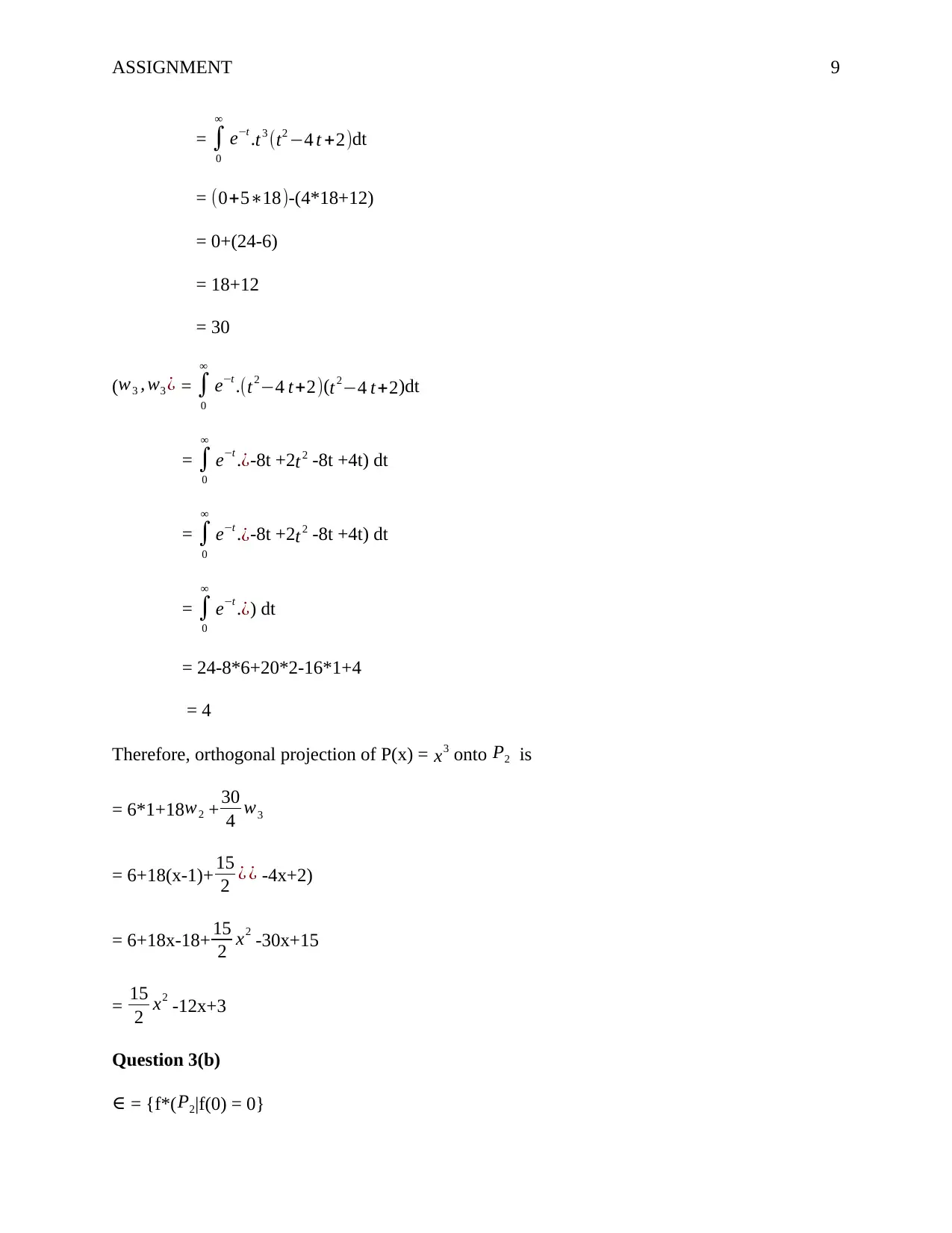
ASSIGNMENT 9
= ∫
0
∞
e−t .t3 (t2 −4 t +2)dt
= (0+5∗18)-(4*18+12)
= 0+(24-6)
= 18+12
= 30
(w3 , w3 ¿ = ∫
0
∞
e−t .(t2−4 t+2)(t2−4 t+2)dt
= ∫
0
∞
e−t .¿-8t +2t2 -8t +4t) dt
= ∫
0
∞
e−t .¿-8t +2t2 -8t +4t) dt
= ∫
0
∞
e−t .¿) dt
= 24-8*6+20*2-16*1+4
= 4
Therefore, orthogonal projection of P(x) = x3 onto P2 is
= 6*1+18 w2 + 30
4 w3
= 6+18(x-1)+ 15
2 ¿ ¿ -4x+2)
= 6+18x-18+ 15
2 x2 -30x+15
= 15
2 x2 -12x+3
Question 3(b)
∈ = {f*(P2|f(0) = 0}
= ∫
0
∞
e−t .t3 (t2 −4 t +2)dt
= (0+5∗18)-(4*18+12)
= 0+(24-6)
= 18+12
= 30
(w3 , w3 ¿ = ∫
0
∞
e−t .(t2−4 t+2)(t2−4 t+2)dt
= ∫
0
∞
e−t .¿-8t +2t2 -8t +4t) dt
= ∫
0
∞
e−t .¿-8t +2t2 -8t +4t) dt
= ∫
0
∞
e−t .¿) dt
= 24-8*6+20*2-16*1+4
= 4
Therefore, orthogonal projection of P(x) = x3 onto P2 is
= 6*1+18 w2 + 30
4 w3
= 6+18(x-1)+ 15
2 ¿ ¿ -4x+2)
= 6+18x-18+ 15
2 x2 -30x+15
= 15
2 x2 -12x+3
Question 3(b)
∈ = {f*(P2|f(0) = 0}
⊘ This is a preview!⊘
Do you want full access?
Subscribe today to unlock all pages.

Trusted by 1+ million students worldwide
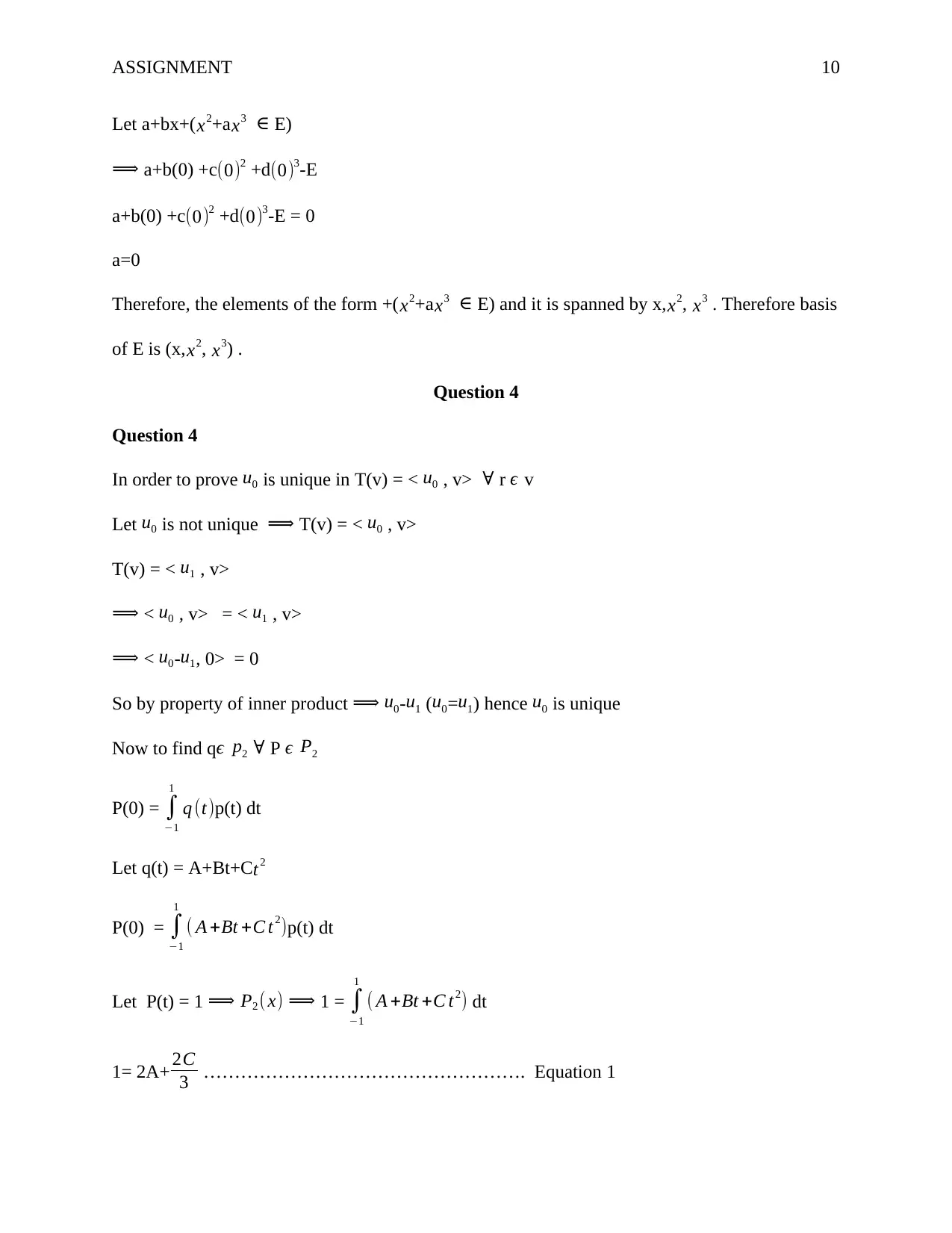
ASSIGNMENT 10
Let a+bx+(x2+a x3 ∈ E)
⟹ a+b(0) +c(0)2 +d(0)3-E
a+b(0) +c(0)2 +d(0)3-E = 0
a=0
Therefore, the elements of the form +( x2+a x3 ∈ E) and it is spanned by x, x2, x3 . Therefore basis
of E is (x,x2, x3) .
Question 4
Question 4
In order to prove u0 is unique in T(v) = < u0 , v> ∀ r ϵ v
Let u0 is not unique ⟹ T(v) = < u0 , v>
T(v) = < u1 , v>
⟹ < u0 , v> = < u1 , v>
⟹ < u0-u1, 0> = 0
So by property of inner product ⟹ u0-u1 (u0=u1) hence u0 is unique
Now to find qϵ p2 ∀ P ϵ P2
P(0) = ∫
−1
1
q (t)p(t) dt
Let q(t) = A+Bt+C t2
P(0) = ∫
−1
1
( A +Bt +C t2)p(t) dt
Let P(t) = 1 ⟹ P2 ( x) ⟹ 1 = ∫
−1
1
( A +Bt +C t2) dt
1= 2A+ 2C
3 ……………………………………………. Equation 1
Let a+bx+(x2+a x3 ∈ E)
⟹ a+b(0) +c(0)2 +d(0)3-E
a+b(0) +c(0)2 +d(0)3-E = 0
a=0
Therefore, the elements of the form +( x2+a x3 ∈ E) and it is spanned by x, x2, x3 . Therefore basis
of E is (x,x2, x3) .
Question 4
Question 4
In order to prove u0 is unique in T(v) = < u0 , v> ∀ r ϵ v
Let u0 is not unique ⟹ T(v) = < u0 , v>
T(v) = < u1 , v>
⟹ < u0 , v> = < u1 , v>
⟹ < u0-u1, 0> = 0
So by property of inner product ⟹ u0-u1 (u0=u1) hence u0 is unique
Now to find qϵ p2 ∀ P ϵ P2
P(0) = ∫
−1
1
q (t)p(t) dt
Let q(t) = A+Bt+C t2
P(0) = ∫
−1
1
( A +Bt +C t2)p(t) dt
Let P(t) = 1 ⟹ P2 ( x) ⟹ 1 = ∫
−1
1
( A +Bt +C t2) dt
1= 2A+ 2C
3 ……………………………………………. Equation 1
Paraphrase This Document
Need a fresh take? Get an instant paraphrase of this document with our AI Paraphraser
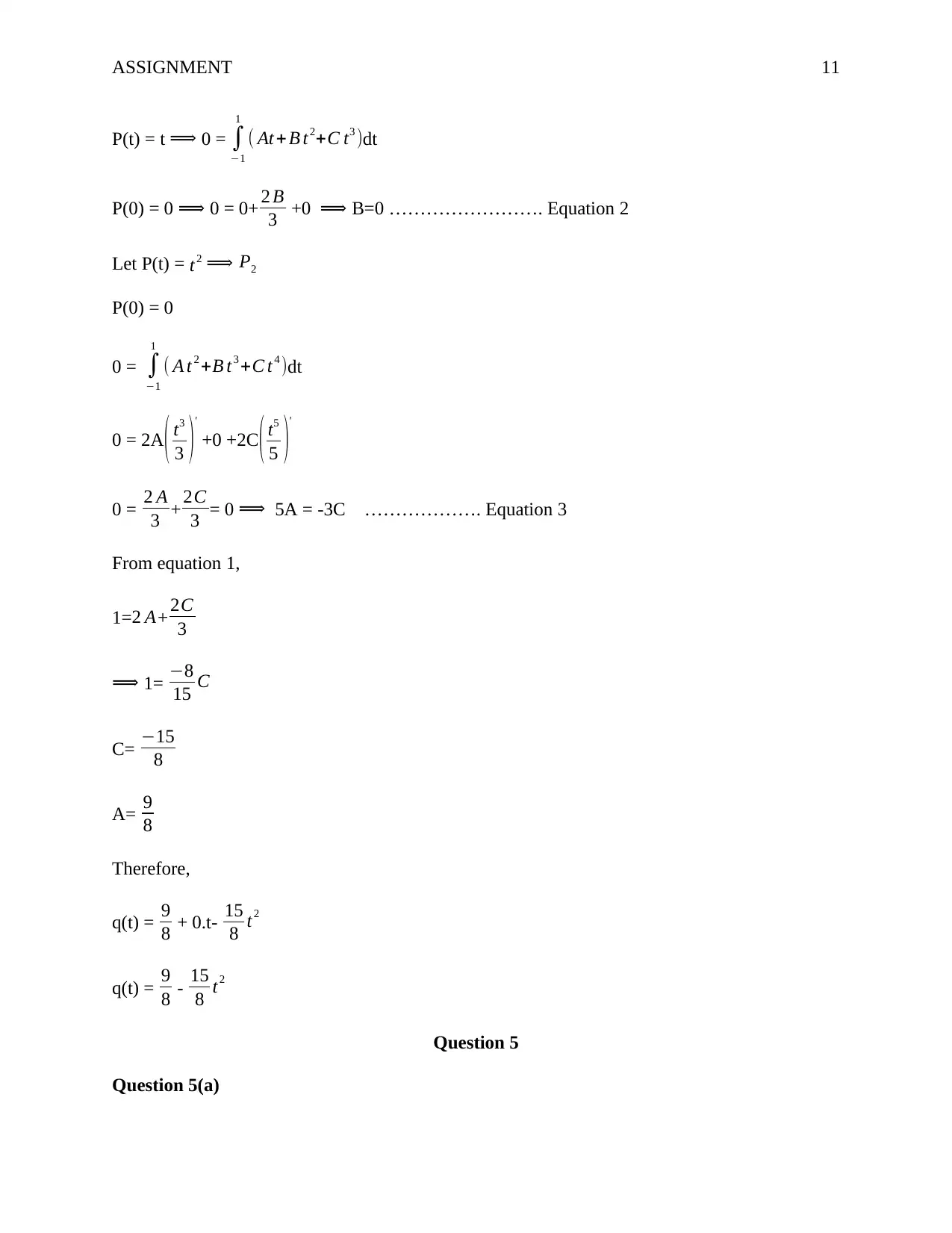
ASSIGNMENT 11
P(t) = t ⟹ 0 = ∫
−1
1
( At + B t2+C t3 )dt
P(0) = 0 ⟹ 0 = 0+ 2 B
3 +0 ⟹ B=0 ……………………. Equation 2
Let P(t) = t2 ⟹ P2
P(0) = 0
0 = ∫
−1
1
( A t 2 +B t3 +C t4 )dt
0 = 2A ( t3
3 )
'
+0 +2C( t5
5 )
'
0 = 2 A
3 + 2C
3 = 0 ⟹ 5A = -3C ………………. Equation 3
From equation 1,
1= 2 A+ 2C
3
⟹ 1= −8
15 C
C= −15
8
A= 9
8
Therefore,
q(t) = 9
8 + 0.t- 15
8 t2
q(t) = 9
8 - 15
8 t2
Question 5
Question 5(a)
P(t) = t ⟹ 0 = ∫
−1
1
( At + B t2+C t3 )dt
P(0) = 0 ⟹ 0 = 0+ 2 B
3 +0 ⟹ B=0 ……………………. Equation 2
Let P(t) = t2 ⟹ P2
P(0) = 0
0 = ∫
−1
1
( A t 2 +B t3 +C t4 )dt
0 = 2A ( t3
3 )
'
+0 +2C( t5
5 )
'
0 = 2 A
3 + 2C
3 = 0 ⟹ 5A = -3C ………………. Equation 3
From equation 1,
1= 2 A+ 2C
3
⟹ 1= −8
15 C
C= −15
8
A= 9
8
Therefore,
q(t) = 9
8 + 0.t- 15
8 t2
q(t) = 9
8 - 15
8 t2
Question 5
Question 5(a)
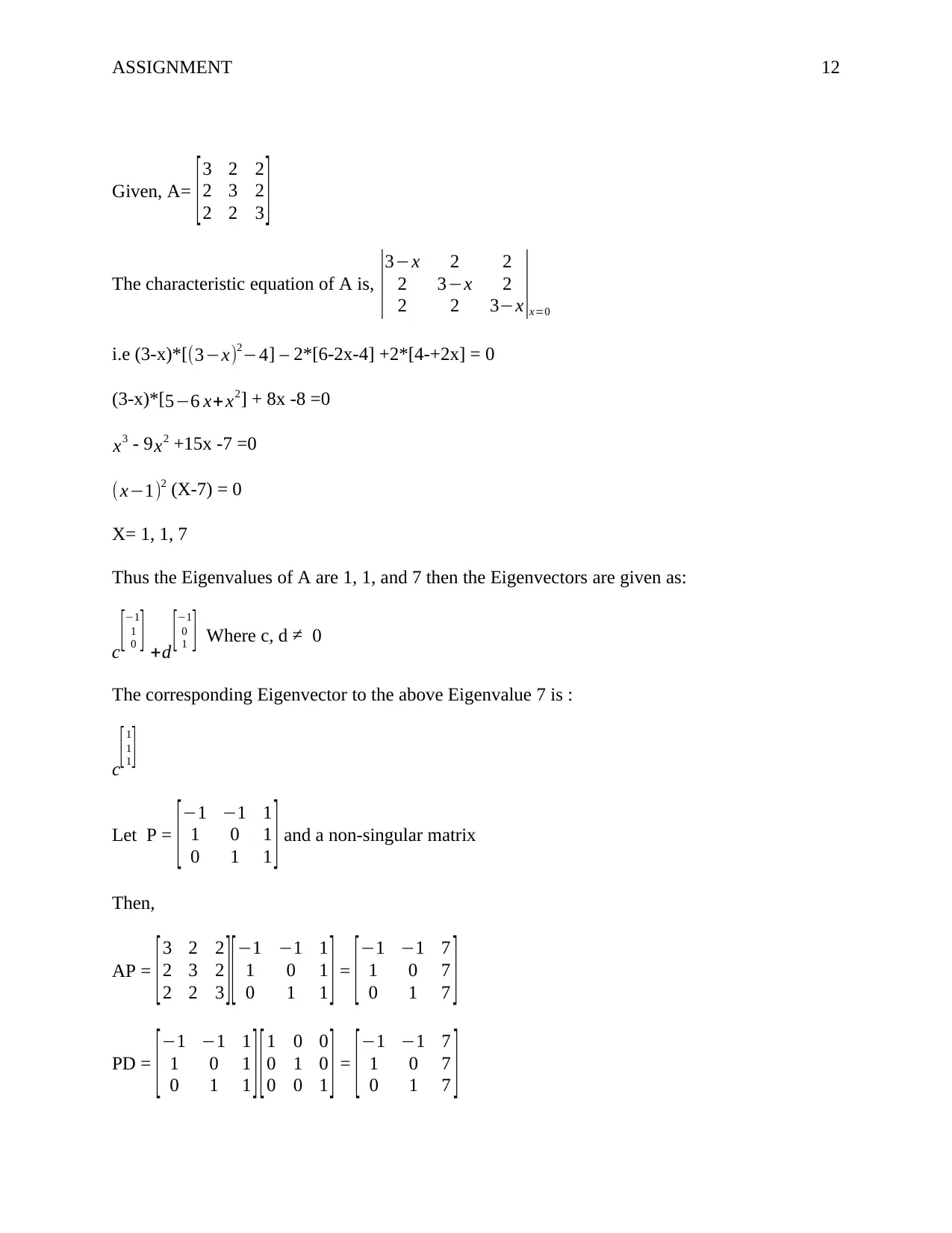
ASSIGNMENT 12
Given, A= [ 3 2 2
2 3 2
2 2 3 ]
The characteristic equation of A is, |3−x 2 2
2 3−x 2
2 2 3−x|x=0
i.e (3-x)*[(3−x)2−4] – 2*[6-2x-4] +2*[4-+2x] = 0
(3-x)*[5−6 x+ x2] + 8x -8 =0
x3 - 9x2 +15x -7 =0
(x−1)2 (X-7) = 0
X= 1, 1, 7
Thus the Eigenvalues of A are 1, 1, and 7 then the Eigenvectors are given as:
c
[
−1
1
0 ] +d [−1
0
1 ] Where c, d ≠ 0
The corresponding Eigenvector to the above Eigenvalue 7 is :
c
[1
1
1 ]
Let P = [−1 −1 1
1 0 1
0 1 1 ] and a non-singular matrix
Then,
AP = [3 2 2
2 3 2
2 2 3 ][−1 −1 1
1 0 1
0 1 1 ] = [ −1 −1 7
1 0 7
0 1 7 ]
PD = [−1 −1 1
1 0 1
0 1 1 ][1 0 0
0 1 0
0 0 1 ] = [−1 −1 7
1 0 7
0 1 7 ]
Given, A= [ 3 2 2
2 3 2
2 2 3 ]
The characteristic equation of A is, |3−x 2 2
2 3−x 2
2 2 3−x|x=0
i.e (3-x)*[(3−x)2−4] – 2*[6-2x-4] +2*[4-+2x] = 0
(3-x)*[5−6 x+ x2] + 8x -8 =0
x3 - 9x2 +15x -7 =0
(x−1)2 (X-7) = 0
X= 1, 1, 7
Thus the Eigenvalues of A are 1, 1, and 7 then the Eigenvectors are given as:
c
[
−1
1
0 ] +d [−1
0
1 ] Where c, d ≠ 0
The corresponding Eigenvector to the above Eigenvalue 7 is :
c
[1
1
1 ]
Let P = [−1 −1 1
1 0 1
0 1 1 ] and a non-singular matrix
Then,
AP = [3 2 2
2 3 2
2 2 3 ][−1 −1 1
1 0 1
0 1 1 ] = [ −1 −1 7
1 0 7
0 1 7 ]
PD = [−1 −1 1
1 0 1
0 1 1 ][1 0 0
0 1 0
0 0 1 ] = [−1 −1 7
1 0 7
0 1 7 ]
⊘ This is a preview!⊘
Do you want full access?
Subscribe today to unlock all pages.

Trusted by 1+ million students worldwide
1 out of 13
Related Documents
Your All-in-One AI-Powered Toolkit for Academic Success.
+13062052269
info@desklib.com
Available 24*7 on WhatsApp / Email
![[object Object]](/_next/static/media/star-bottom.7253800d.svg)
Unlock your academic potential
Copyright © 2020–2025 A2Z Services. All Rights Reserved. Developed and managed by ZUCOL.





